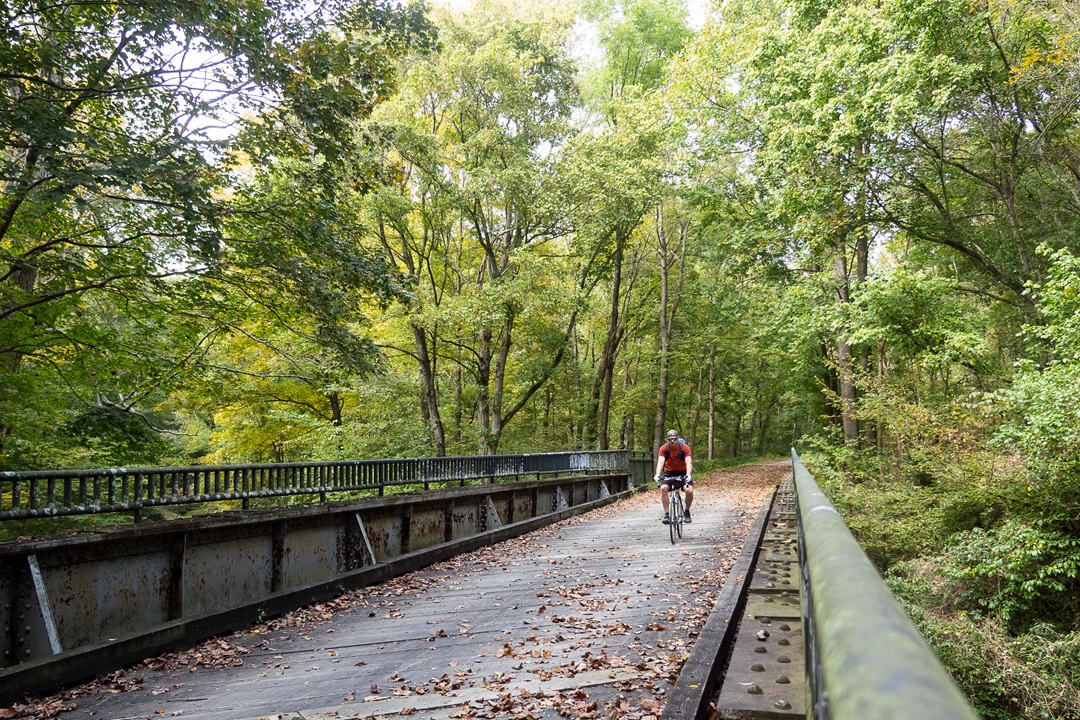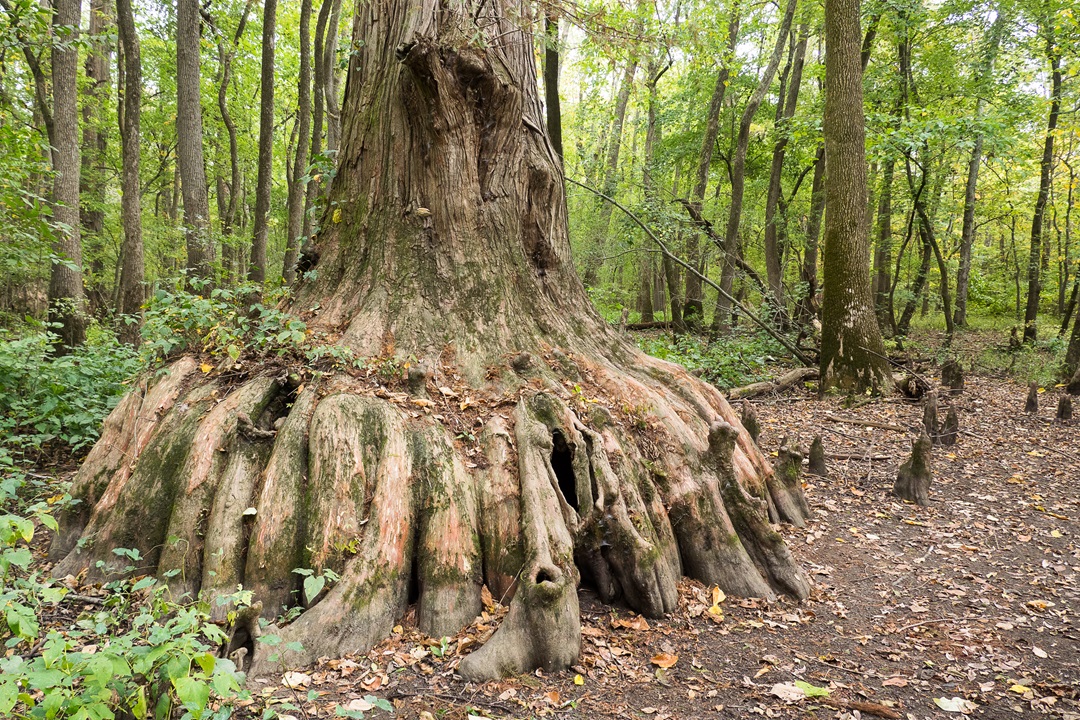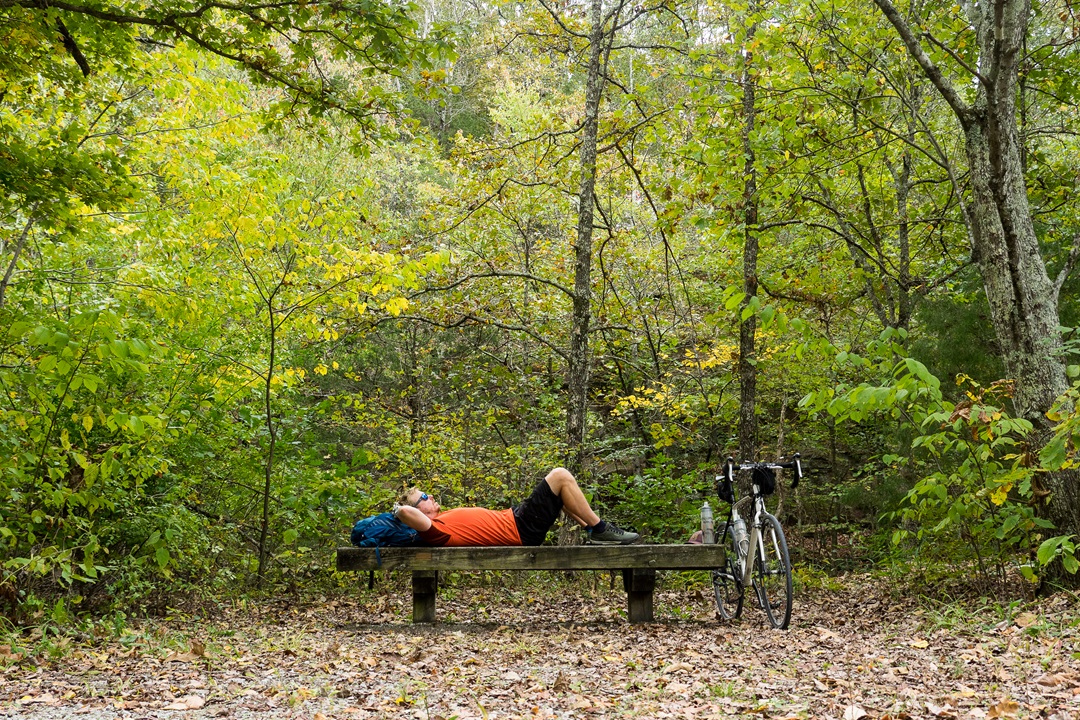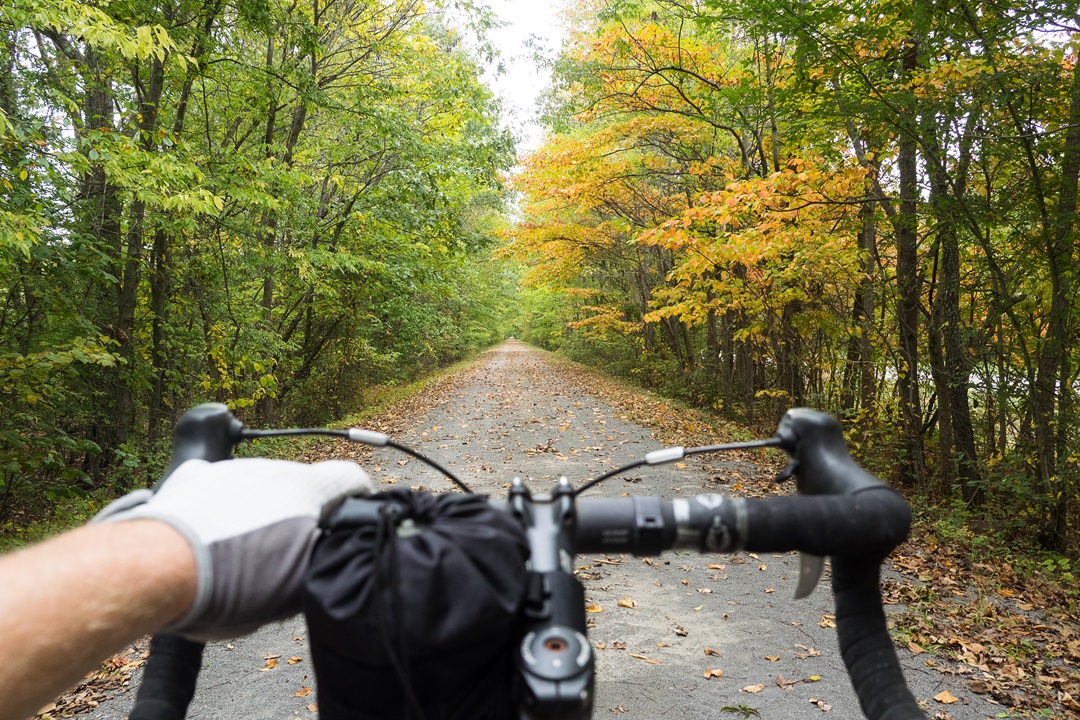“I’ve never had any problems,” said the jogger, “but can’t promise anything.”
We were standing in a small trailhead parking lot in Karnak, and I’d just asked the friendly passerby if he thought it was safe for me to leave a vehicle there. I was in unfamiliar territory — a rural village a few miles from the Ohio River in far Southern Illinois.
After he left, I continued prepping my gravel bike for an out-and-back ride on the southern half of the 55-mile Tunnel Hill State Trail. I’d heard good things about this crushed limestone rail trail over the years, but had never had the chance to check it out for myself. Until now.
I was about to start my ride when something odd happened. A very large man driving a very small car pulled into the lot. Another man arrived in a pickup. A third man in a van. And a fourth, in a rusty hatchback, parked next to me. Each stared straight ahead, like operatives in a Cold War spy movie. Was I being surveilled by the local KGB — the Karnak Get-outta-here-you-dirty Biker organization?
Curious, I said hello to the hatchback driver, who rolled down his window. Wouldn’t you know, he was the nicest itinerant construction worker I ever met. They were all on a break from a nearby bridge project that “just wouldn’t end.” We talked for a half-hour about the places we’d visited across the country.
By the time I pedaled north, I regretted not inviting him to ride with me on my handlebars.
Heron Pond & Beyond
From Karnak, the first 5 miles on Tunnel Hill State Trail were a straight shot northeast through parts of the Cache River State Natural Area. It was a Friday in mid-October, and the leaves were a mix of green, yellow, and orange. I passed a few farms, one of which displayed two of the large stencil sasquatches that roam the region.
Where the trail curved north, I detoured east onto Heron Pond Road. Less than a mile of gravel road led uphill to a trailhead for a 1.5-mile nature hike. I’d recently made the controversial decision to swap clipless pedals for flats on my gravel bike. Instead of cleated shoes, I now wore rubber-soled mountain bike shoes, which I prefer for exploring on foot during an adventure ride.

Tunnel Hill offers 55 miles of crushed limestone rail trail. (Mike Bezemek)
Since bikes aren’t allowed on the nature trail, I dismounted and walked past the largest cherry bark oak in the state. The best part was the Heron Pond boardwalk. Due to a recent drought, the water had mostly dried up. But the bald cypress still towered overhead, with needle-like leaves beginning to turn a burnt ochre.
The only other visitor was a wildlife photographer lying on a bench, staring at the treetops. “Not many people make it out here,” she observed.
North of Heron Pond Road, the Tunnel Hill State Trail began to gradually wind uphill. The gravel surface was smooth. The elevation gain was about 600 feet over 15 miles. The riding was easy. The higher I went, the more interesting the scenery became. Shortly after passing the visitor center in Vienna, the route began to parallel Little Cache Creek. The woods thickened, and one section briefly passed through Shawnee National Forest.
I crossed an impressive series of old train bridges and trestles high above the creek, which deepened into a miniature gorge. Occasionally, the trail squeezed through tight passages blasted into limestone. After a few hours of pedaling, I’d encountered only a handful of people on my ride to the top.
The Tunnel Hill State Trail follows the former bed of the Cairo and Vincennes Railroad, which was founded in 1872 by Ambrose Burnside. Yes, the same Civil War general whose distinctively groomed facial hair led to the term sideburns. The original tunnel was about 800 feet long. A collapse in the late 1920s led to it being shortened to its current length of 543 feet.
Walking my bike inside the damp tunnel, it became so dark I couldn’t see anything but the bright portals at either end. Outside, it was beginning to rain. So, I hustled on the 20-mile ride back down to my truck.
DIY Research
During my few days in the area, I stayed at the pleasant Redbud Campground, nestled in pine woodland at the Bell Smith Springs Recreation Area in Shawnee National Forest. While I might have cooked, I didn’t bother upon discovering the campground well was dry. Instead, I went out for dinner each night, mostly in the nearby town of Vienna. I was curious about the region, and sometimes the best way to learn is by talking with locals and fellow visitors.
That was the idea, at least, on my first evening. Shortly after setting up camp, I stopped by the U.S. Forest Service ranger station. The young staffer behind the information counter appreciated me reporting the well issue, but when I began to ask questions about the outdoor recreation opportunities and history of the forest, his eyes widened in embarrassment. Soon, he was hiding in the back office while I was collecting every map and brochure available for some DIY research. I briefly considered hopping behind the desk and clocking in, but I’m not really suited for government work.

Unique surroundings make Tunnel Hill one of the best rail trails in the Midwest. (Mike Bezemek)
Sometimes, the best place for good intel is a local watering hole. There wasn’t much to pick from, so I selected a motorcycle bar and grill on the edge of town. Normally, I’m more of a microbrewery and craft IPA kind of guy, but I know how to blend in when necessary. I dropped elbows on the countertop next to the tattooed bartender and ordered a simple beer.
“I’ll take a Busch.”
“Which kind?” she quizzed me. “We got Busch Light, Busch Ice, Busch Gold, Busch Apple.”
“Uh, just a regular Busch,” I stammered, my eyes widening like the young ranger’s had. “I didn’t even know there were that many types of Busch.”
When she handed me a regular Busch in the blue can with gold trim, I put two and two together. But now all five regulars at the bar were staring at me like I was from another planet. So, I trudged outside to the patio and I read through 50 tourist brochures by myself.
North Side of the Trail
On Saturday morning, I parked at the trailhead in Stonefort. Nearby, four retired e-bikers were getting ready. My day two plan was to ride 11 miles up the north side of Tunnel Hill State Trail and return. Then, I could ride the mostly flat trail through farmlands toward its northern terminus. Some articles said that was in Harrisburg. Others said it was 7 miles further in Eldorado, which turned out to be true.
For 9 miles my ride went well. The hilly, north-side scenery was similar to the south side. A meandering route followed scenic Pond Creek through colorful woods and across regular bridge crossings. The elevation gain was less on this side, just under 400 feet and gradual. But the surface was rougher, with pockets of loose sand, especially above New Burnside. There were more people out for the weekend, but not many. Perhaps two dozen cyclists and around the same number of walkers.
I stopped at a pair of interesting cement bridge pilings rising perpendicularly above the path. Here, I met a nice couple biking downhill. Together, we pondered what was clearly a former intersection of two railroads, the lower one now a rail trail and the upper one almost entirely removed and erased by encroaching forest.
Recently, my bike seat had been sagging, and I stopped twice to raise it and tighten the bolt. The third time, I heard a grinding sound as the bolt head snapped off. The seat swung loosely atop the post, nearly a foot short of the needed height. Suddenly, the situation dawned on me. I was 9 miles from my truck. Reluctantly, I began an agonizing return ride, alternating between stand-up sprinting and sit-down coasting. By the time I reached my truck an hour later, I could barely walk.
That afternoon, I limped inside the Bike Surgeon repair shop in the nearby city of Carterville. I ended up spending the rest of the day with the friendly owner and his cycling pals. While they drilled out the bolt, I limped out to my truck for the cooler. While we drank beer and shared stories of favorite trails, the shop owner sold e-bikes to an entire family.
On the counter, they had recent issues of Terrain Magazine stacked up. One of the pals began flipping through, looking for my articles. It was one of those unexpected afternoons with instant friends that often happens among outdoor folks. By the time I left, my seat was fixed and I held hopes of returning someday for a group ride on the local mountain bike trails.

After biking the entire Tunnel Hill State Trail, you might want a nap. (Mike Bezemek)
A “Recovery” Day
Of course, on my final day, I now had a dilemma. I had three sections of trail still to ride: a few miles on the southernmost end, 2 scenic miles just north of Tunnel Hill, and 20 flat miles running alongside Highway 45 from Stonefort to Eldorado.
My ridiculously sore legs nixed the longer segment, so I focused on the first two.
After touring the small museum at the Barkhausen Wetlands Center, I painfully climbed onto my bike. It wasn’t pretty, but I rode a few wobbly miles through the nature preserve to the largest bald cypress tree in Illinois. With an 11-foot diameter, it’s almost 1,000 years old — sort of like how my quads felt.
My first visit to a new favorite rail trail was coming to an end. Before calling it a day, I rode the last section around Tunnel Hill State Trail. Plus, another 4 miles because I’m bad at moderating. Afterward, I was hobbling through the parking lot when I met two women cyclists from St. Louis. After laughing about my hard-earned limp, the conversation shifted to our impressions of the trail.
Like me, they were pleasantly shocked by this trail. And like them, I was in full agreement that someday — when, hopefully, I’ve regained the ability to walk — I’ll be back.
***
Tunnel Hill State Trail Facts
Location: Johnson, Pulaski, Saline, and Williamson counties in Southern Illinois
Length: 55.2 miles
End Points: Barkhausen-Cache River Wetlands Center in Cypress and Eldorado High School Athletic Fields in Eldorado
Surface: Crushed limestone, pavement, and boardwalk
Amenities: Drinking water, privy toilets, and parking at access points; Visitor Center at State Highway 146 in Vienna
Activities: Cycling, walking, running
Website: dnr.illinois.gov/parks/park.tunnelhill.html
Author: Mike Bezemek is a regular contributor to Terrain Magazine.
Top image: Bezemek on the Tunnel Hill rail trail. (Mike Bezemek)


Leave A Comment